Fitness test for stone dykes
What is the condition of the dykes in the Dutch province of Zeeland? How strong are the revetments used to clad them thirty years ago? These are important questions for the Scheldestromen water authority because a large proportion of the dykes they manage have stone revetments. Research by Deltares is helping them to decide where best to target their capacity and maintenance budget. Tensile tests were conducted on behalf of Rijkswaterstaat this summer on the dyke bordering the Zimmerman polder.

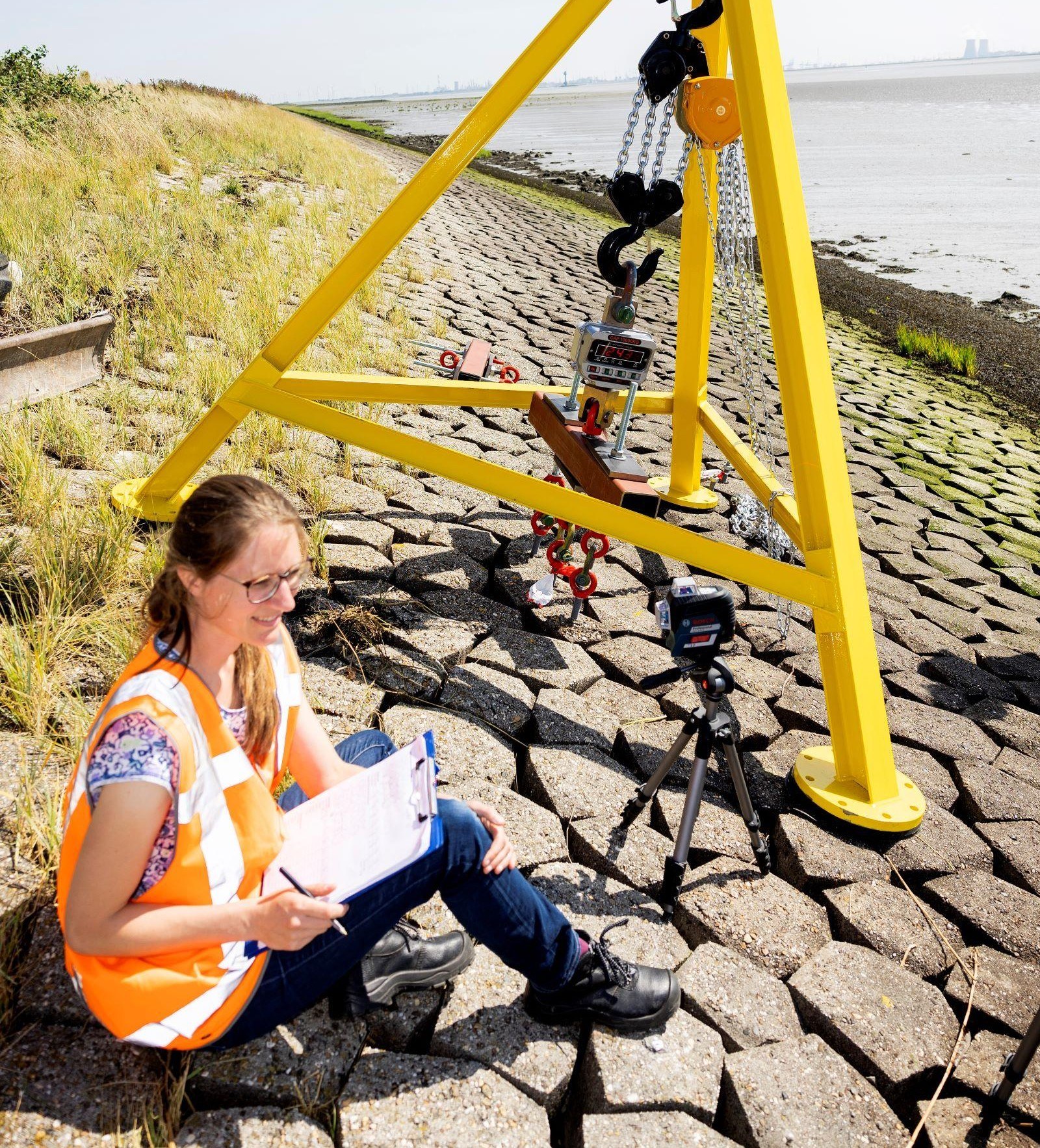
A small Delta research team went to a location near Waarde to investigate the condition of the stone revetment on the dyke next to the Western Scheldt. They first subjected the revetment to a simulated storm by letting the small pebbles between the large stones wash out. The second step followed on a sunny day in late summer: testing the strength and clamping of the revetment by pulling at ‘sets’ of stones.
Deltares researcher Nova Huppes and her colleagues Tijl Wijnants and model technician Danny van Doeveren conducted these tests where dyke inspectors from the Scheldestromen Water Authority had seen anomalies. “From the outside, you see flat stones but they are actually concrete columns that can go down as far as fifty centimetres to a base of crushed rock,” says Nova. “The idea behind our tensile test is that if you can pull them up easily, there is a weak spot. If more pulling force is needed, the stones are still wedged in firmly. That’s important to cope with the wave forces during a superstorm.” The aim of the Deltares study is to identify differences in strength between a well-laid revetment and a revetment with shortcomings such as sagging stones or large spaces between stones.
Millimeters
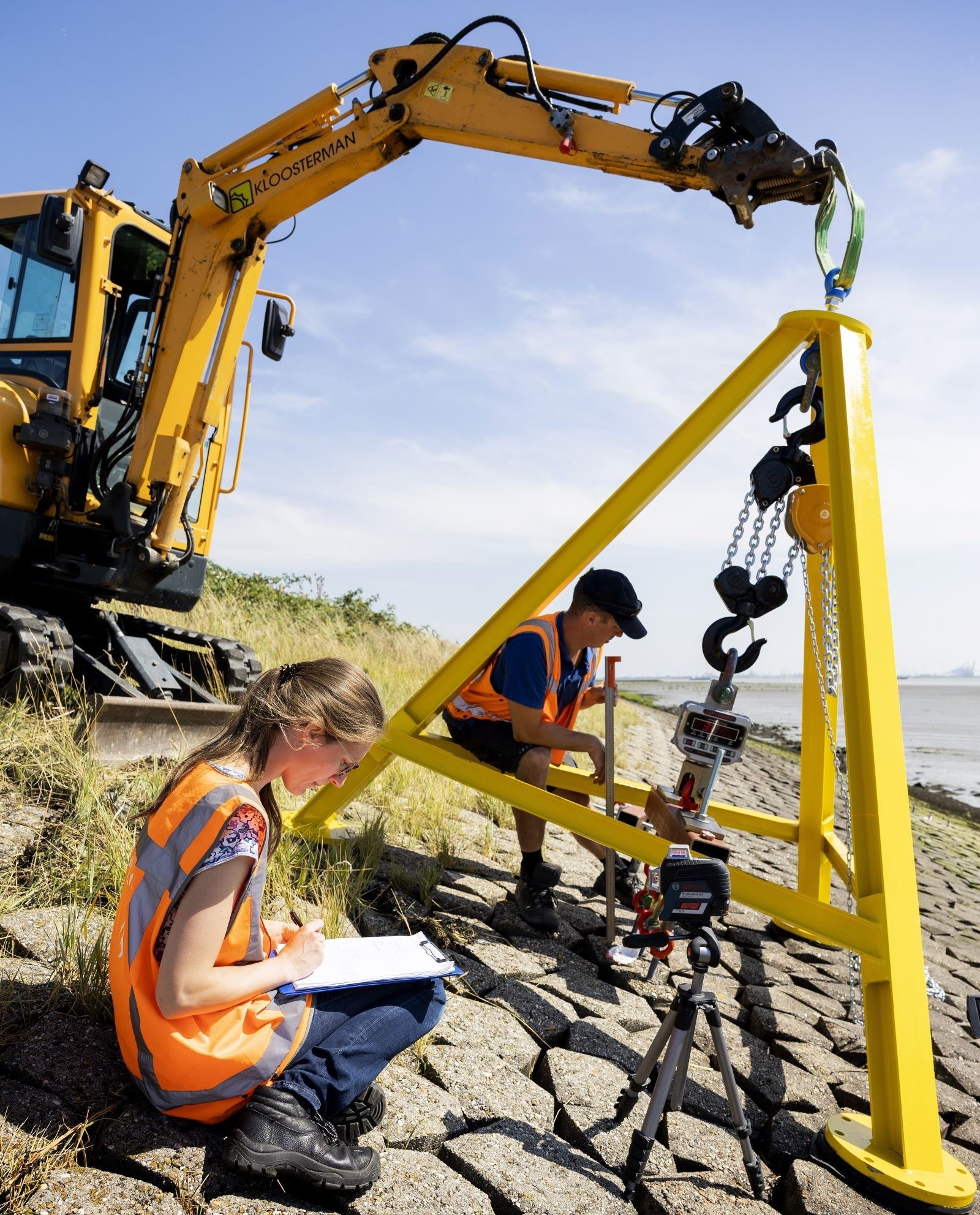
How do you pull stones out of a dyke? Using a carefully designed lifting device in a tripod, the researchers lifted three stone columns at a time step-by-step, reading off the force required in kilogrammes from a hook scale. The researchers then used a spirit level and cross-line laser to check that they were they were lifting perpendicular to the slope and a tape measure to measure the distance between the lifting beam, or cross-beam, and the stones. In this way, they were able to determine to within a millimetre how much the stones had come up. A camera filmed all the results just in case they missed a measurement.
Tijl operated the lifting device while Nova took down the measurements. By hand, “because a tablet’s battery runs out too quickly.” The crane operator drilled the tie rods into the stones and sawed them off again after the test “so that no one can trip over them.” In this way, one hundred and fifty measurements were conducted in three days.
Slope
Raymond Derksen of the Scheldestromen Water Authority was closely involved in setting up the tests. “There’s quite a bit involved,” says Raymond. “The selection of the right locations, ordering your equipment, all the general preparations and drawing up a timetable that includes the tides. There is also dense vegetation on the dyke in some locations and things can be slippery in others.” Nova saw that the trolley for the measuring equipment was not the best idea on the sloping dyke. “That’s fieldwork: there are always surprises. Fortunately, with help from Raymond, we were able to call in several crane operators. They used cranes to move the tripod.”
In any case, it was useful that Raymond was there to keep an eye on things during the tests because “he has a more detailed knowledge of the location and its history,” says Nova. “And it was nice to see how Raymond felt just as responsible for the success of our fieldwork as we did. The Water Authority allowed us to work on their dykes and, of course, they couldn’t know in advance whether the tests would be successful.”
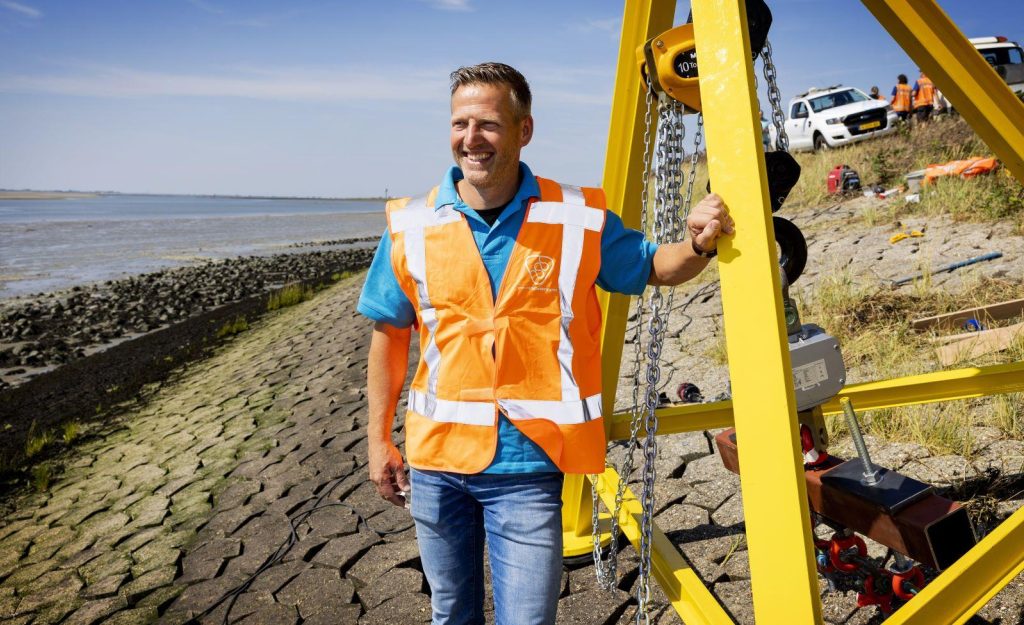
House of cards
Raymond has been working on all the sea dykes with stone revetments at Scheldestromen since 2003. “Between 1996 and 2015, all the dykes along the Eastern and Western Scheldt and North Sea coasts were reinforced, and I think I went to every dyke section beforehand. I could select locations for these tests by heart. On a good section, the stones are laid neatly alongside each other and there are still plenty of small stones around them,” he says. “In weak spots, the small stones have been washed out, or the stones stick out or lean forward.”
The reasons vary, Raymond explains. “Sometimes it’s because of the location of the dyke and the wave action there, the stability of the subsurface or the construction. You have to remember that the tides complicate work on a dyke: the contractors were only able to work at low tide and so the time pressures were enormous. As a result, some of the stone columns may not have been pushed in as firmly. Once you have got them in, you can’t take them out: the entire revetment would collapse like a house of cards.”
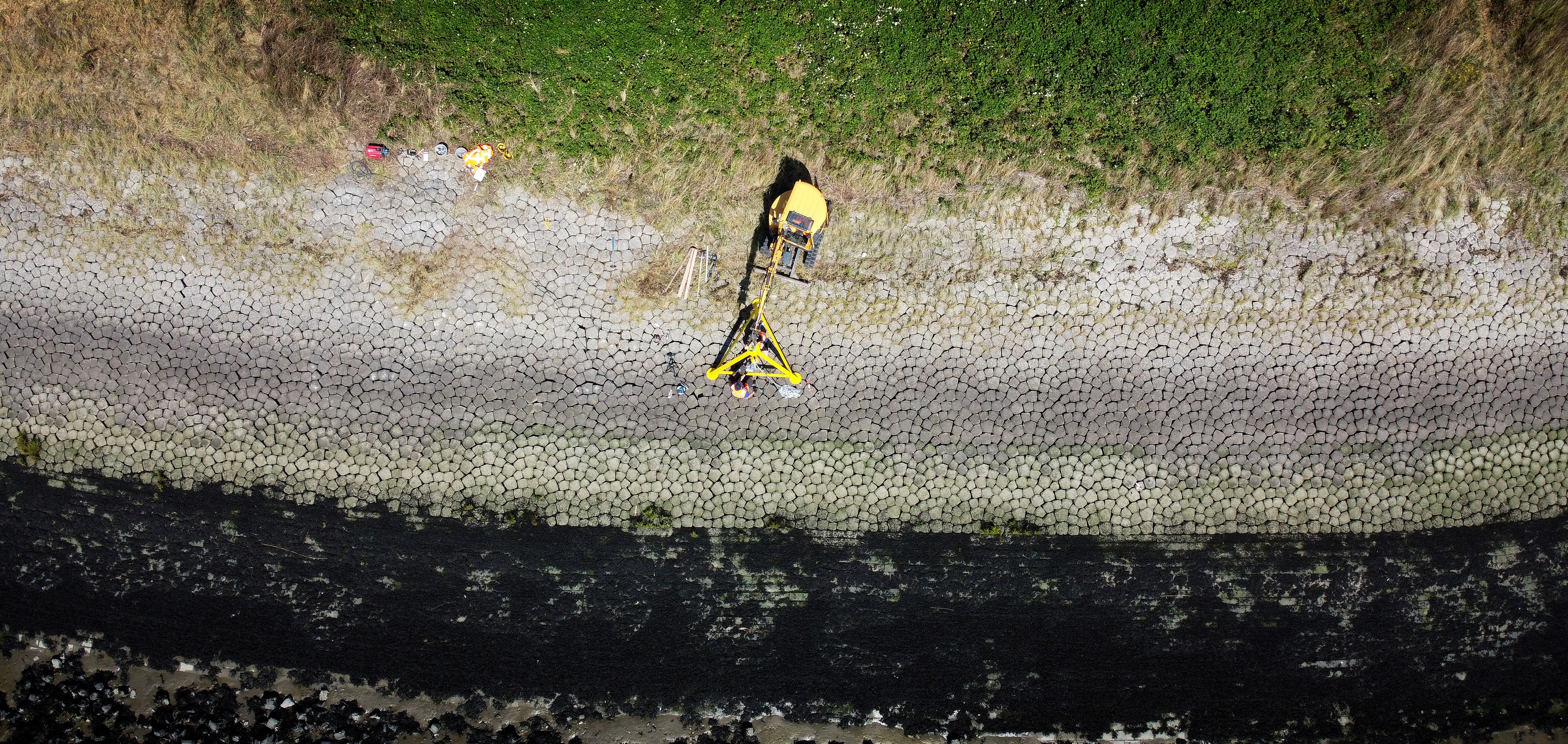
Expectations
The reinforcement operation, that lasted until 2015, provided the Water Authority with a lot of data. “We measured all of our dykes, from the thickness and length of the stone columns to the subsurface,” says Raymond. “We complement this information with observations made during our dyke inspections; we take our fieldwork back to the office, as it were. On that basis, we worked with Deltares to identify the locations for the tests. We expect that the research results will allow us to draw conclusions about the strength of the revetments in other places, not just in Zeeland but also in the rest of the country.”
Better protection against flooding
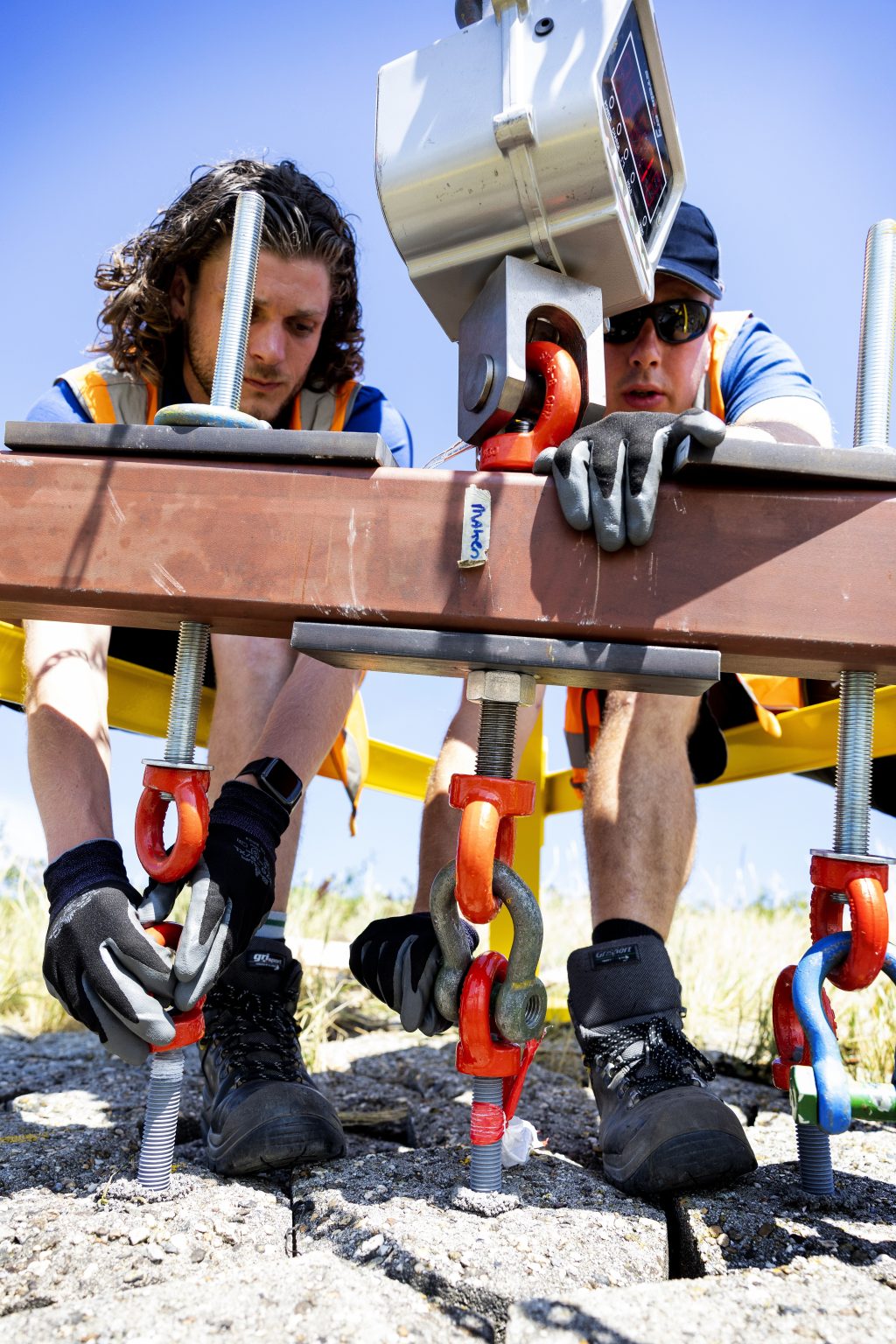
Nova is working at Deltares on a range of studies related to flood risk management because “the benefits for society are so obvious. Dykes protect us.” She also loves complex puzzles. “We don’t know exactly how that mass of concrete on these dykes behaves. We once thought that this approach to covering dykes worked well, but the consequences of how nature interacts with it will always remain a bit of a mystery. I find it fascinating to study that.”
Raymond agrees. “The nice thing about my work is that it is never finished: there is always something to do. Most of Zeeland’s dykes were tackled during the Delta Works after the disastrous floods of 1953. In the 1990s, the stone revetments were reinforced during the Sea Defences project. Now they are being tested again and the conclusion is that a quarter are not stable enough. Our dykes have been there for centuries and everyone thinks they are finished, but there is also a lot we don’t know. Will they do their job in a storm that occurs once every ten thousand years? We still have 25 years to strengthen all the dykes: they have to meet the new standards for flood risk management by 2050.”
Decisions
It is particularly useful to know more about the condition of the dykes in this respect, says Raymond. “The dyke upgrades have to be paid for. The number of people in Zeeland is relatively low in comparison with the number of kilometres of dyke that need strengthening. In addition, finding enough people to actually do the work is also an issue. So as a Water Authority, we have to make careful decisions about where we target our time and money. If this study shows that some revetments are still in good condition, that represents an enormous cost saving.”




